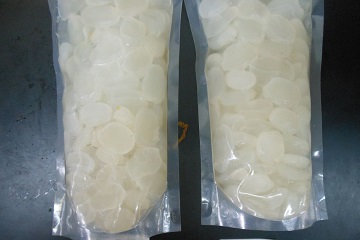IPB Researchers Search for the Most Suitable Packaging for Kolang Kaling

Kolang kaling, fruit that comes from sugar palm has the potential to be developed as a healthy food. This fruit contains galactomannan compound. Dr. Emmy Darmawati, a researcher at the Department of Mechanical and Biosystem Engineering, Bogor Agricultural University (IPB) explained that galactomannan has health benefits. "Galactomannan that are added to food products can improve fiber content in foods," she said.
Kolang kaling can be found a lot in traditional markets with minimum handling. As a result, the fruit often suffers damage such as enzymatic browning caused by the oxidation of the polyphenoloxidase enzyme and the change of texture to softer. Traditionally, to reduce the browning process is usually done by soaking kolang kaling in drums/bucket containing water and then replacing the water for every three days.
According to Dr. Emmy, the use of packaging and the addition of lime solution as a source of natural citric acid in water can reduce the enzymatic browning and maintain the quality of kolang kaling. Dr. Emmy and his fellow researchers Amarilia Harsanti Dameswari and Dr. Lilik Pujantoro Eko Nugroho examines the effect of packaging, the water to kolang kaling ratio, and the citric acid concentration of lime added to the water in maintaining the quality of the kolang kaling during the storage.
The research team started the study by looking for the best water to kolang kaling ratio and citric acid concentration to maintain the quality of kolang kaling. In the next stage, the researchers packed kolang kaling with vacuum packaging and plastic pouch and then stored at 5 degrees Celsius. Plastic pouch that has been filledwith kolang kaling will then moderately sealed, while for vacuum packaging, after being filled with kolang kaling then sealed with vacuum technique. The net per pack weight of kolang kaling is 500 grams with the size 15 x 25 cm for plastic pouch and vacuum packaging. PE plastic bags were used as control variable, which were generally used by people daily.
"PE packaging affects the quality of kolang kaling during storage, thus PE combined with nylon packaging is better in maintaining the quality of kolang kaling. Plastic pouch that were made from PE with nylon combined with water (ratio 1: 3) and citric acid 0.1 percent are able to maintain galactomannan content from 4.73 percent to 3.08 percent with color and texture condition still accepted by consumers up to 9 days of storage," she said. (FM)



